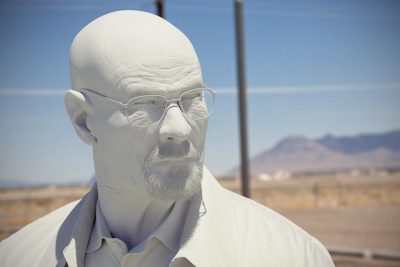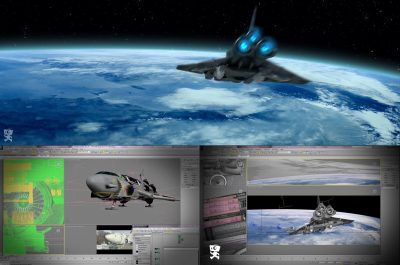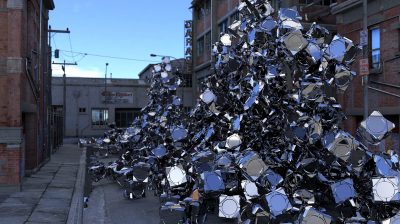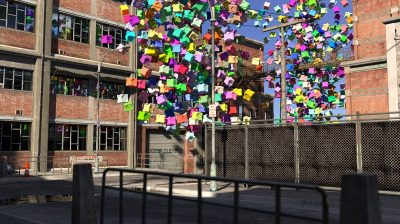OTOYs Octane renderer was previewed in fxguide’s Art of Rendering article in the middle of last year. The product, now released and out of beta, is creating quite a stir for its remarkable GPU-based rendering. Octane Render is a real-time 3D unbiased rendering application that was started by the New Zealand company Refractive Software. OTOY is now developing the program. It is the first commercially available unbiased renderer to work exclusively on the GPU, and runs exclusively on Nvidia’s CUDA technology. OTOY sells Octane as a stand alone renderer as well as a plugin to popular 3D applications such as Max and Maya. The company has strong links to cloud computing and graphics research. OTOY also owns LightStage, LLC in Burbank which did the facial scanning for The Avengers, among other films, and Paul Debevec is their “chief scientific consultant”.
 Clearly these guys know what they are doing.
Clearly these guys know what they are doing.
None of the gains OTOY are currently showing would have been viable on consumer GPUs prior to 2010. This is why Octane Render is so much faster than CPU-based rendering systems. It was designed from the ground up to tap into the massive – and cheap — computational and rendering power on recent consumer GPUs.
Octane started life in New Zealand and its original founder Terrence Vergauwen remains central to its development. Most of the development continues in New Zealand. OTOY has four main offices – two in LA (including LightStage), and two in New Zealand. While Octane runs on the PC, the company is moving to a new cloud solution. The product is launching on Kepler cards, but the cloud solution will allow offline rendering in the cloud, and the company has invested heavily in a GPU cloud render farm. This is a custom built specialist GPU farm using Nvidia GPUs, this is not a front to a third party farm from say Amazon or some other primary CPU farm provider. This will allow, when released, users to render on one local Kepler card or on as many GPU farm processors as they like.
“If you wanted a 1000 GPUs on a single process, Octane scales linearly with each GPU you added,” explains Jules Urbach, OTOY chief executive officer. “We are looking at thousands and down the line tens of thousands of GPUs for offline rendering – that will be one way that it will work. There will also be a live version, there are iterations we have shown with Autodesk of Max already running Octane without any local GPU and that is one of our core competencies,” he adds.
Pricing on the offline and live per hour rendering are not yet released. But to give one a guide, while OTOY won’t name actual pricing, on Amazon similar computer power would be a couple of dollars per hour. OTOY are aiming to “significantly beat that price,” says Urbach. “To my knowledge, we are the first to build a Kepler rack like this for rendering like this.
The farm will be sub 10,000 GPUs for the beta period but it will grow when the cloud Octane rendering moves out of beta. The cloud per hour realtime rendering could be used for gaming, previs and noise free 4K rendering in realtime, the limit would be the latency of your internet or network setup. The company has their own codecs for streaming and encoding in the gaming space and servicing space. The company is however eyeing technology two years ahead. Already today they can do ray tracing in realtime but with some noise. “But that is just a cost problem,” says Urbach, referring to the amount of hardware you can apply to their linear scaling problem. As such there are already two large game companies that are looking at this technology for high end realtime ray traced gaming down the track.
One possible solution to high end gaming would be a hybrid solution with some local computing on your own GPU and having high end lightmaps, texture maps, voxel maps and more being streamed in from the cloud Octane. The company has already done 25 co-efficient spherical harmonics lighting systems (directional ambient occlusion) – Paul Debevec has actually tested to 8000 coefficients. To give that perspective, on Avatar, Weta used nine coefficients in PantaRay for their pipeline. A lot of this research is an intersection of the LightStage research, spherical harmonics (used commonly in games for realtime performance) and their Octane rendering / cloud rendering.
March 18-21 San Jose
S3442 – The Convergence of Cinema and Games: From Performance Capture to Final Render.
Jules Urbach (Founder and CEO, OTOY Inc. and LightStage )
Day: Tuesday, 03/19
Time: 16:00 – 16:50
Location: Room 210B
The product was in beta for almost two years. The new Kepler GPU cards were released by Nvidia late last year. Nvidia launched the Tesla K20 GPU accelerators at the Supercomputing 2012 (SC12) show in November, but surprisingly the Octane renderer and several other programs ran initially slower on the new cards. This delayed OTOY’s release as they solved the unique issues the Kepler cards threw up. “No one expected that, not even Nvidia, we were slower, iRay was slower – everyone was slower,” explains Urbach. “It took about five months – the last five months of the beta bringing it up to speed… we did this with help from Nvidia – they have been really supportive and I think they were pretty impressed and now we are speaking at GTC – and talking about our experiences, and now we are looking at Kepler 2.”
The Octane renderer has the following features:
- fully GPU based
- fully interactive
- physically based materials and lighting
- realistic camera model (supporting realtime depth of field)
- un-biased spectral algorithms
- includes SSS and complex materials
- includes instancing
It is an unbiased ray tracer that runs completely on the GPU. This is unusual as normally GPU ray tracers sacrifice accuracy in order to provide performance. OTOY are claiming a 10x to 50x speed increase over traditional, CPU based unbiased ray tracers, without cutting corners on accuracy.
NB: Above and below are a collection of images posted by OTOY from their user submission. Credit has been given where we have it.
SSS

The image to the right is a sub-surface scattering (SSS) render based on OTOY’s own LightStage data – it is 17,000,000 polygons. It was Path tracing @ 1000s/px, using SSS. It took 2 minutes on 2 GTX 680. It uses an HDRI environment map lighting and rendered at 2048×1024 resolution.
The image is noiseless after 8 seconds with just one GTX 680 using Octane Render v1.01 (which features environment map importance sampling).
No normal/bump maps used in this version, and this is not the final quality possible but a key test done in late December by Samuel Lapere, a graphics developer at OTOY.
The sub-surface is only at the earlier stages, there is more information coming the LightStage scans and one of the aims for the group for this year is to more closely integrate LightStage and the Octane renderer. This image is not a fully accurate render, “that is to come”, but rather a creative render.
OTOY designed Octane as a rendering tool to work with common off-the-shelf graphics processors — like the kind from AMD and Nvidia that most people already have in their home workstation PCs. While cloud computing can disrupt many local industries by bringing Silicon Valley power to remote locations, OTOY is using its research to squeeze more power out of the computer sitting on your desk.



Octane operates as a plug-in with popular 3D modeling and artistry software like Autodesk Maya 3D Studio Max, and other programs.
The stand alone version does not support animation, but this is expected mid year. There is also a plugin coming for Blender. This is one of the most requested plugins by the user group. As Blender is more open source and clearly not Autodesk. OTOY is committed to supporting a wide range of plugins for all the major packages.
Autodesk is close to the company and works well with the OTOY team but it is mainly interested in gaming and realtime rendering and it does not define the Octane roadmap. “They are not directing us,” the OTOY team states point blank.
Hardware
Octane Render requires a CUDA enabled NVIDIA video card. An up to date list can be found here.
If someone is interested in purchasing a new graphics card to use with Octane Render, OTOY recommends the Geforce GTX570 or GTX 580 as currently having the best price/performance ratio. The latest generation of Nvidia GPUs (Kepler) is supported, but currently works slower than their Fermi equivalents. OTOY state on their web site that they are still optimizing the performance of Octane on the Kepler GPUs. “The GeForce line is higher clocked and renders faster than Quadro and Tesla GPUs, but the latter GPUs often have more memory. A powerful multi-core CPU is not required as Octane does not use the CPU for rendering, but a faster CPU will improve the scene voxelizing speed.”
 Camera features
Camera features
One of the earliest features was accurate cameras.
From the earliest days of the product the renders supported tone mapping, with accurate film stocks and while much of that was developed for stills, and the team is looking to extend this to some more video specific tone maps. But for now the tone mapping functions produce rich and interesting final images.
The newest version has additional bloom and flares. (Glint and Glare are in Octane 1.01)
There is also fogs and caustics. The fog is a full volumetric solution.
Motion Blur
Motion blur is only in the Max and Maya plugins as the stand alone version does not support animation. On Max and Maya motion blur is currently supported but it is not as fast as the team would like and they are looking to revised the Max and Maya motion blur around the middle of the year. Similarly the team is looking to allow the stand alone version to import Alembic animation files or something similar. Alembic support “is a potential thing, we have not announced it yet, it could be one way for us to add animation to the stand alone version.”
Deep channel kernel
Deep channel kernel includes the following layer options:
- z depth
- p-maps
- shading normals
- material ids
- UV co-ordinates
- tangent map normals
- shadow capture materials (coming soon)
Price
Octane Render Standalone Edition v1.0 License (199 €) but there is a great free demo version which is easy to use and extremely impressive. As the stand alone edition does not do animation yet, the Maya and Max versions are worth investigating. The Octane Render for Autodesk® 3ds max® + Standalone Combo v1.0 License” is 359 € for example.
Note the early beta was only €49.
Brigade
OTOY is also working on Brigade, a technology to render cloud-based games with high-quality 3D graphics. Brigade is a different renderer to Octane, more of a test bench for the OTOY. Not much has been published about it, but test renders with incredibly impressive results have been posted on OTOY blogs.
A new test with the Brigade path tracer, showing 1024 physics driven dynamic cubes in a street scene. It’s incredibly fun to fly through a photoreal scene in real-time while tons of cubes are falling from the sky in slow motion and being able to change all the lighting and materials at the same time. The beauty of how instancing works in Brigade is that moving hundreds or even thousands of rigid objects happens for free, with almost no impact on the rendering performance.
 Brigade also doesn’t care much about how many polygons these rigid objects contain: a 100K poly Stanford dragon will render nearly as fast as 3K poly Utah teapot. This opens up a lot of possibilities: you could for example render scenes with hundreds of spaceships flying around in an extremely detailed procedurally generated landscape. Dealing with non-rigid meshes like animated characters is a bit harder for a path tracer, because acceleration structures need to be updated every frame
Brigade also doesn’t care much about how many polygons these rigid objects contain: a 100K poly Stanford dragon will render nearly as fast as 3K poly Utah teapot. This opens up a lot of possibilities: you could for example render scenes with hundreds of spaceships flying around in an extremely detailed procedurally generated landscape. Dealing with non-rigid meshes like animated characters is a bit harder for a path tracer, because acceleration structures need to be updated every frame
Brigade is designed for speed, it has separate code space. It is designed for speed not accuracy, but it shares code and was “taken out of the labs and incorporated in Octane”. While the product will be commericalized, right now it is not a commercial program. It is a demo and research piece. While very few features have so far moved from Brigade to Octane this is about to change.
OTOYs approach with Brigade is indicative of the company’s whole approach, which is to be open with their users and the community, let people see what they are working on in the labs and share their results as they move forward. As such we can see incredibly interesting glimpses into what gaming and rendering could look like in two to three years, and it is pretty impressive.





Thanks for the great article! I’m following the Octane news for quite some time now and might purchase it as soon as the Maya plugin goes out of beta. During my research on GPU renderers I also came along a renderer called FurryBall 3.0. Tho, it’s not physically based rendering you might want to have a look at it (if you haven’t already).
Fantastic article! I’m happy to see Octane get some love. I’ve been using Octane render since the beta and haven’t gone back to Mental Ray since. That beta price sure was sweet. I was saying it then and I’ll say it now. Unless something drastic happens on the CPU render front, GPU rendering is the future of graphics processing. Just look up Nvidia Maximus.
Pingback: Octane Render WARNING FAILED TO RENDER for 3dsmax - taukeke
Pingback: The State of Rendering – Part 2 | 次时代人像渲染技术XGCRT
Pingback: GPU computing breakthrough? Cloud rendering company claims to run CUDA on non-Nvidia GPUs | BiznessWeb: Last News in on place updated every hour
Pingback: GPU computing breakthrough? Cloud rendering company claims to run CUDA on non-Nvidia GPUs | NUTesla | The Informant
Pingback: GPU computing breakthrough? Cloud rendering company claims to run CUDA on non-Nvidia GPUs – Viral News
Pingback: GPU computing breakthrough? Cloud rendering company claims to run CUDA on non-Nvidia GPUs - News Today
Pingback: GPU computing breakthrough? Cloud rendering company claims to run CUDA on non-Nvidia GPUs | Horizon Post
Pingback: GPU computing breakthrough? Cloud rendering company claims to run CUDA on non-Nvidia GPUs - Clicking-droid
Pingback: GPU computing breakthrough? Cloud rendering company claims to run CUDA on non-Nvidia GPUs - Viralround the world
Pingback: GPU computing breakthrough? Cloud rendering company claims to run CUDA on non-Nvidia GPUs - Viral clock
Pingback: GPU computing breakthrough? Cloud rendering company claims to run CUDA on non-Nvidia GPUs - Josefnews
Pingback: GPU computing breakthrough? Cloud rendering company claims to run CUDA on non-Nvidia GPUs – Latest Viral News
Pingback: GPU computing breakthrough? Cloud rendering company claims to run CUDA on non-Nvidia GPUs - Decratonews
Pingback: GPU computing breakthrough? Cloud rendering company claims to run CUDA on non-Nvidia GPUs - Anozaa
Pingback: GPU computing breakthrough? Cloud rendering company claims to run CUDA on non-Nvidia GPUs | News Ask
Pingback: GPU computing breakthrough? Cloud rendering company claims to run CUDA on non-Nvidia GPUs | Peaks Media
Pingback: MediaPeak | GPU computing breakthrough? Cloud rendering company claims to run CUDA on non-Nvidia GPUs
Pingback: GPU computing breakthrough? Cloud rendering company claims to run CUDA on non-Nvidia GPUs - Memoricatrend
Pingback: GPU computing breakthrough? Cloud rendering company claims to run CUDA on non-Nvidia GPUs - Interdependentnews
Pingback: GPU computing breakthrough? Cloud rendering company claims to run CUDA on non-Nvidia GPUs - Edxviral
Pingback: GPU computing breakthrough? Cloud rendering company claims to run CUDA on non-Nvidia GPUs - Abbos1
Pingback: GPU computing breakthrough? Cloud rendering company claims to run CUDA on non-Nvidia GPUs - Kygoronews
Pingback: GPU computing breakthrough? Cloud rendering company claims to run CUDA on non-Nvidia GPUs - Kenleeviral
Pingback: GPU computing breakthrough? Cloud rendering company claims to run CUDA on non-Nvidia GPUs - Pobierzgrac
Pingback: GPU computing breakthrough? Cloud rendering company claims to run CUDA on non-Nvidia GPUs | Its Likely News
Pingback: GPU computing breakthrough? Cloud rendering company claims to run CUDA on non-Nvidia GPUs - Global-Noose
Pingback: GPU computing breakthrough? Cloud rendering company claims to run CUDA on non-Nvidia GPUs - Exodiaznews
Pingback: GPU computing breakthrough? Cloud rendering company claims to run CUDA on non-Nvidia GPUs - Novaviral
Pingback: GPU computing breakthrough? Cloud rendering company claims to run CUDA on non-Nvidia GPUs - Optmicizer
Pingback: GPU computing breakthrough? Cloud rendering company claims to run CUDA on non-Nvidia GPUs - Realtimetrack
Pingback: GPU computing breakthrough? Cloud rendering company claims to run CUDA on non-Nvidia GPUs - Anthropinews
Pingback: GPU computing breakthrough? Cloud rendering company claims to run CUDA on non-Nvidia GPUs - Viralcliq
Pingback: GPU computing breakthrough? Cloud rendering company claims to run CUDA on non-Nvidia GPUs - Enchantotrend
Pingback: GPU computing breakthrough? Cloud rendering company claims to run CUDA on non-Nvidia GPUs - Makerbakertrend
Pingback: GPU computing breakthrough? Cloud rendering company claims to run CUDA on non-Nvidia GPUs - Laziralnews
Pingback: GPU computing breakthrough? Cloud rendering company claims to run CUDA on non-Nvidia GPUs - Kanbandviral
Pingback: GPU computing breakthrough? Cloud rendering company claims to run CUDA on non-Nvidia GPUs - Vitaltrend
Pingback: GPU computing breakthrough? Cloud rendering company claims to run CUDA on non-Nvidia GPUs - Mixalareviral
Pingback: blackmirror clip Share This article Lifelogging cameras, despite having been floating around in various R&D labs for well over a decade and inspiring many a strange and wonderful science fiction tale, have categorically failed to take hold in the mai
Pingback: GPU computing breakthrough? Cloud rendering company claims to run CUDA on non-Nvidia GPUs - Locks News Network!
Pingback: GPU computing breakthrough? Cloud rendering company claims to run CUDA on non-Nvidia GPUs | Gear Media
Pingback: GPU computing breakthrough? Cloud rendering company claims to run CUDA on non-Nvidia GPUs | Media Well
Pingback: GPU computing breakthrough? Cloud rendering company claims to run CUDA on non-Nvidia GPUs | News Fetch
Pingback: GPU computing breakthrough? Cloud rendering company claims to run CUDA on non-Nvidia GPUs | Media News
Pingback: http://www.extremetech.com/computing/224599-gpu-computing-breakthrough-cloud-rendering-company-claims-to-run-cuda-on-non-nvidia-gpusGPU computing breakthrough? Cloud rendering company claims to run CUDA on non-Nvidia GPUs | Bruce's Blog
Pingback: GPU computing breakthrough? Cloud rendering company claims to run CUDA on non-Nvidia GPUs - Thisnews
Pingback: GPU computing breakthrough? Cloud rendering company claims to run CUDA on non-Nvidia GPUs | Count News
Pingback: GPU computing breakthrough? Cloud rendering company claims to run CUDA on non-Nvidia GPUs - The latest International World News
Pingback: GPU computing breakthrough? Cloud rendering company claims to run CUDA on non-Nvidia GPUs | Wrap News
Pingback: GPU computing breakthrough? Cloud rendering company claims to run CUDA on non-Nvidia GPUs | Viral World news
Pingback: GPU computing breakthrough? Cloud rendering company claims to run CUDA on non-Nvidia GPUs | Politi Byte
Pingback: GPU computing breakthrough? Cloud rendering company claims to run CUDA on non-Nvidia GPUs - ExtremeTech - Computers
Pingback: GPU computing breakthrough? Cloud rendering company claims to run CUDA on non-Nvidia GPUs – The Tech News
Pingback: GPU Computing Breakthrough? Cloud Rendering Company Claims To Run CUDA On Non-Nvidia GPUs | TechVictory.com
Pingback: GPU computing breakthrough? Cloud rendering company claims to run CUDA on non-Nvidia GPUs
Pingback: Empresa de serviços em Nuvem afirma executar CUDA em GPUs não Nvidia. – eXtremeMods – Tecnologia